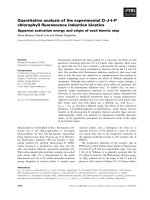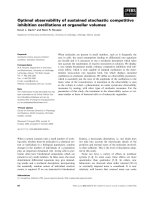Báo cáo khoa học: "Optimal management of the high risk surgical patient: beta stimulation or beta blockade" pdf
Bạn đang xem bản rút gọn của tài liệu. Xem và tải ngay bản đầy đủ của tài liệu tại đây (33.09 KB, 2 trang )
645
DO2 = oxygen delivery; GDT = goal directed therapy; ICU = intensive care unit; RCRI = Revised Cardiac Risk Index; ScvO2 = central venous
oxygen saturation.
Available online />Abstract
Several groups of investigators have shown that peri-operative
goal directed therapy (GDT) may reduce mortality in high-risk
surgical patients. GDT usually requires the use of beta-adrenergic
agents, however, and these may also carry the risk of cardiac
ischemia, especially in patients with ischemic diseases. In this
commentary, we will discuss the apparent contradiction between
studies showing beneficial effects of GDT in high-risk surgical
patients and studies showing the benefit of beta-blockade in high-
risk surgery. One of the key differences between both types of
studies is that GDT is applied in patients with high risk of post-
operative death, excluding patients with cardiac ischemic disease,
while studies reporting beneficial effects of beta-blockade have
investigated patients with high risk of cardiac ischemia but
moderate risk of death related to the surgical procedure itself. It is
likely that beta-blockade should be proposed in patients with
moderate risk of death, whereas GDT using fluids and inotropic
agents should be applied in patients with high risk of peri-operative
death. Monitoring central venous oxygen saturation may be useful
to individualize therapy, but further studies are required to validate
this option.
The peri-operative care of high-risk surgical patients remains
a challenge. Despite improvement in surgical and anes-
thesiological procedures, the mortality of high-risk surgical
procedures remains above 10%. In these patients, peri- and
post-operative alterations in oxygen transport are closely
related to the development of organ failure and death [1,2].
This led to the concept that increasing deliberately oxygen
delivery (DO2) may prevent the development of organ failure.
Several studies have reported that peri-operative hemo-
dynamic optimization (goal directed therapy (GDT)) guided
by the pulmonary artery catheter may decrease morbidity and
mortality [3-7]. GDT is usually based on generous fluid
administration and, if needed, beta-adrenergic agents,
including dobutamine [3,6] and dopexamine [4,5]. Several
questions remain unanswered, however, and limit the wide
application of GDT in patients submitted to high-risk surgery.
Can GDT be initiated only after admission in
the intensive care unit?
One major limitation of GDT is that it was usually initiated in
the operating room or even sometimes before the intervention.
This is usually difficult to apply, either because of bed
shortage or because the assessment of peri-operative risk of
death is sometimes difficult before the surgical intervention.
Some surgical interventions may indeed be much easier than
predicted, and the patients would then have been submitted
to useless or even deleterious GDT, while other interventions
are sometimes unexpectedly complicated and GDT is not
provided to these patients. In this issue of Critical Care,
Pearse et al. [8] elegantly avoided these problems. They
investigated the effects of GDT applied only when the patient
is admitted to the intensive care unit (ICU), when peri-
operative risk of death may be more easily determined. They
used fluids and dopexamine to increase DO2 (to a target of
600 mL/min.m
2
) for 8 h. The DO2 target was achieved in 80%
of the GDT group and in 45% of the control group. Fewer
patients developed complications in the GDT group than in
the control group (this was the primary outcome of the study),
leading to a shortened hospital stay. Mortality (at 28 days) was
similar in both groups and lower than the mortality predicted
by the P-POSSUM score (actual 9.7% versus predicted
18.5% in GDT and actual 11.7% versus predicted 13.7% in
control group). Thus, Pearse et al. [8] nicely demonstrated
that GDT can be successfully initiated after ICU admission.
Should GDT be individualized?
GDT therapy is based on the principle that DO2 should be
deliberately increased in order to prevent tissue hypoxia.
Commentary
Optimal management of the high risk surgical patient:
beta stimulation or beta blockade?
Daniel De Backer
Assistant Professor, Department of Intensive Care, Erasme University Hospital, Free University of Brussels, Belgium
Corresponding author: Daniel De Backer,
Published online: 22 November 2005 Critical Care 2005, 9:645-646 (DOI 10.1186/cc3930)
This article is online at />© 2005 BioMed Central Ltd
See related research by Pearse et al. in this issue [ and />646
Critical Care December 2005 Vol 9 No 6 De Backer
However, DO2 is probably unnecessarily increased in some
patients in whom a lower DO2 value may also be adequate.
Mixed venous and central venous (ScvO2) oxygen saturations
reflect the balance between oxygen requirements and DO2,
and may thus be used to assess the adequacy of DO2.
Pearse et al. [9] also measured ScvO2 in most of the patients
investigated in their study assessing the efficacy of GDT [8].
They reported that ScvO2 fluctuated over the 8 h period,
independently of changes in DO2 [9]. Patients with lower
ScvO2 values had more post-operative complications. The
ScvO2 cut-off value of 64.4% can be used to discriminate
patients with complicated and with uncomplicated post-
operative course. Future studies are required to investigate
whether post-operative optimization should be guided by
ScvO2 or based on predefined DO2 values.
Are beta-blocking agents indicated in some
patients?
These data suggesting that GDT should be implemented in
high risk surgical patients should be balanced by some data
suggesting that beta-blocker agents may be beneficial in
these patients [10,11]. Lindenauer and colleagues [11]
recently suggested that patient safety may be enhanced by
increasing the use of beta-blockers in high-risk patients
submitted to major non-cardiac surgery. This was a retro-
spective non-interventional study. Beta-blocking agents were
used in 18% of 700,000 patients who had no contra-
indication for beta-blockade, and the outcome of these
patients receiving beta-blockade was compared to the other
patients, using a propensity score to match patients for
confounding factors. In that study, beta-blockade was
associated with a reduced risk of in-hospital death only in the
subgroup of patients with Revised Cardiac Risk Index (RCRI)
scores of 3 or more. This study deserves several comments.
First, the subgroup with a RCRI score of 3 or more was very
small, representing only 1.9% of the propensity matched
cohort. Given the very limited number of available patients in
this category (6,264 patients), it is very likely that matching
groups was incomplete so that confounding factors may
participate in differences in outcome. On the contrary,
evidence that beta-blockade therapy increased the risk of
death in patients with RCRI scores below 2 is much more
robust, as this analysis included the vast majority of the
patients (80% of the cohort). Second, RCRI assess
specifically the cardiac risk of the patient, not the mortality
related to the surgical procedure. Accordingly, mortality was
6% to 7% in the patients with RCRI scores of 3 and more. A
high-risk surgical procedure was performed in a minority of
the patients, and the effects of beta-blockade were neutral in
these patients.
How to reconcile these apparently opposed
results?
In an attempt to reconcile both views, one could propose that
patients with a high risk of peri-operative cardiovascular
events (high RCRI scores) should be dissociated from
patients with high risk of peri-operative death. In the first
group, beta-blockade should be proposed, whereas in the
second one, GDT using fluids and inotropic agents should be
applied. Patients combining high cardiac risk and high peri-
operative risk of death have not been studied, it may appear
logical to provide GDT, but limiting as much as possible the
use of beta-stimulation in these patients.
Maybe ScvO2 should be used to guide therapy in place of
DO2. This may appear attractive, as it may be justified to
further attempt to increase DO2 when ScvO2 is low while it
may be justified to avoid the use of beta-adrenergic agents
when ScvO2 is high enough. This should be tested in further
studies.
Competing interests
The author(s) declare that they have no competing interests.
References
1. Bland RD, Shoemaker WC, Abraham E, Cobo JC: Hemodynamic
and oxygen transport patterns in surviving and nonsurviving
postoperative patients. Crit Care Med 1985, 13:85-90.
2. Shoemaker WC, Chang PC, Czer LSC, Bland R, Shabot MM,
State D: Cardiorespiratory monitoring in postoperative
patients: I. Prediction of outcome and severity of illness. Crit
Care Med 1979, 7:237-242.
3. Shoemaker WC, Appel PL, Waxman K, Schwartz S, Chang P:
Clinical trial of survivors’ cardiorespiratory patterns as thera-
peutic goals in critically ill postoperative patients. Crit Care
Med 1982, 10:398-403.
4. Boyd O, Grounds M, Bennett ED: A randomized clinical trial of
the effect of deliberate perioperative increase of oxygen
delivery on mortality in high- risk surgical patients. J Am Med
Asoc 1993, 270:2699-2707.
5. Wilson J, Woods I, Fawcett J, Whall R, Dibb W, Morris C,
McManus E: Reducing the risk of major elective surgery: ran-
domised controlled trial of preoperative optimisation of
oxygen delivery. Br Med J 1999, 318:1099-1103.
6. Lobo SM, Salgado PF, Castillo VG, Borim AA, Polachini CA,
Palchetti JC, Brienzi SL, de Oliveira GG: Effects of maximizing
oxygen delivery on morbidity and mortality in high-risk surgi-
cal patients. Crit Care Med 2000, 28:3396-3404.
7. Kern JW, Shoemaker WC: Meta-analysis of hemodynamic opti-
mization in high-risk patients. Crit Care Med 2002, 30:1686-
1692.
8. Pearse R, Dawson D, Fawcett J, Rhodes A, Grounds M, Bennett
D: Early goal-directed therapy after major surgery reduces
complications and duration of hospital stay. A randomised,
controlled trial [ISRCTN38797445]. Crit Care 9:R687-R693.
9. Pearse R, Dawson D, Fawcett J, Rhodes A, Grounds M, Bennett
D: Changes in central venous saturation following major
surgery, and association with outcome. Crit Care 9:R694-
R699.
10. Mangano DT, Layug EL, Wallace A, Tateo I: Effect of atenolol on
mortality and cardiovascular morbidity after noncardiac
surgery. Multicenter Study of Perioperative Ischemia
Research Group. N Engl J Med 1996, 335:1713-1720.
11. Lindenauer PK, Pekow P, Wang K, Mamidi DK, Gutierrez B, Ben-
jamin EM: Perioperative beta-blocker therapy and mortality
after major noncardiac surgery. N Engl J Med 2005, 353:349-
361.









